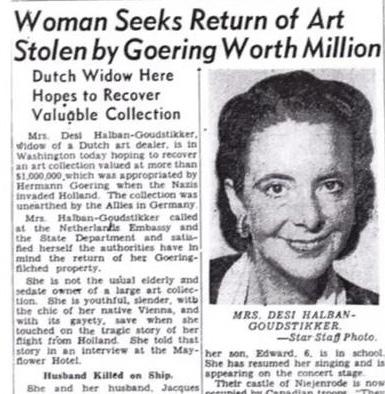The Last Prisoners of War
T
he last prisoners of war could soon be coming home. Many works of art looted from Jews of Nazi-occupied Europe that have yet to be recovered by their rightful owners, each with its unique story, may be redeemable in a new restitution paradigm arising in prominent galleries worldwide. Driven by activists in Germany and The Netherlands, museum collectors, curators, and preservationists, are making public their new imperative: to redress injustice. It may seem like slim compensation for direct or distant loved ones, but the admission that every act of theft led to suffering and death would set the record straight and be a precedent in other negotiations. The new paradigm does away with statutes of limitation. It defends the individual’s right to ownership over the desires and rationalizations of renowned museums which defend their collections come what may. The die was cast a year ago in a stunning reversal of a policy that had THEODORE ROSENGARTEN tried to balance an institution’s innocence and ignorance of an object’s origins with the degree of coercion that led a previous owner to sell it or give it away. In February 2021, the German Advisory Commission on the return of Nazi-era cultural property recommended the restitution of the watercolor Crouching Female Nude by Austrian figurative painter Egon Schiele, a protégé of Gustav Klimt. Once owned by Viennese dentist and collector Heinrich Rieger, the figurative work was held by the city of Cologne which contended that it had been voluntarily sold or gifted by Dr. Rieger prior to the Anschluss of March 1938, which gave Hitler the prize of Austria through peaceful annexation. But Cologne could not produce evidence to support its claim. Rieger and his wife were murdered at Theresienstadt in 1942. Not long after deciding for Rieger’s heirs, the advisory committee continued its pivot to the side of the victim in a case brought with the hope of “encouraging other parties and countries to come forward.” Jewish collector Kurt Grawi purchased Franz Marc’s Expressionist painting, Die Fuches (The Foxes) in 1928. Grawi’s properties were seized by the Nazi government in 1935, though he managed
6
HOLOCAUST REMEMBERED |
A U.S. soldier examines a piece of art in a room full of Nazi-looted items. Franz Marc, Die Fuches (The Foxes)
to smuggle Marc’s work to Paris. In 1938, following the Kristallnacht pogrom, he was imprisoned at Sachsenhausen concentration camp. Released early in 1939, he fled Germany to Chile, covering the cost of emigrating by having the painting shipped to New York and sold for a fraction of its worth. Over the next twenty years it changed hands several times, and in 1962 The Foxes was donated by the owner of a chain of German department stores to the Dusseldorf City Art Collection. In 2015, Grawi’s heirs appealed to the city for the art work’s restitution and were turned down. Yet last May, the Advisory Commission
Egon Schiele, Crouching Female Nude Courtesy egon-schiele.net APRIL 27, 2022
|
Restitution—of silver kiddish cups, medieval haggadot, drawings by Old Masters, portraits of 16th century Jewish merchants, landscapes of Russian steppes—meant “more than just the return of an item of cultural value” but a process that should be “experienced as contributing to the restoration of rights.” reversed itself and recommended that the painting be restored to the heirs. What made the case unusual was that the sale of the painting had taken place beyond the Third Reich and the Commission took the bold step of projecting its non-binding jurisdiction “outside the Nazi sphere of influence.” The sale, it concluded, was “so closely connected with National Socialist persecution that the location of the event becomes secondary in comparison.” The city agreed and aligned itself with the recommendation and the reasoning behind it. The decision to return the painting recognized Grawi’s suffering under the Nazis, placing the owner’s experience first. It redefined what it means to sell under duress and rejected the museum’s appeal couched in the language of civic pride, that since “entering the city’s art collection in 1962,” the painting “had pride of place at the Dusseldorf Kunstpalast.” Simultaneously, in neighboring Holland, Minister of Culture Ingrid van Engelshoven set out a new restitution policy, repudiating the notion that “the good faith of the acquiring institution” be taken into account. In place of the contentious “balance of interests test,” she called for “an assessment framework … [where] there is the presumption of involuntary loss.” The hearing must “strive for completeness” by making applicants feel they are being heard. The mayor of Amsterdam
Supplement created and paid for by the SOUTH CAROLINA COUNCIL ON THE HOLOCAUST
weighed in, declaring that “as a city we have a role and responsibility in this.” Restitution—of silver kiddish cups, medieval haggadot, drawings by Old Masters, portraits of 16th century Jewish merchants, landscapes of Russian steppes—meant “more than just the return of an item of cultural value” but a process that should be “experienced as contributing to the restoration of rights.” How will the new paradigm play in the United States? In Detroit and Philly, New York and LA, Norman, Oklahoma and Toledo, Ohio, and other cities, where museums are hard-pressed financially and fighting to hold onto assets that were somebody’s looted property, heirs are contesting ownership and threatening to sue. Here is one thing we can say: the movement to restore plundered art to its Jewish owners has inspired restitution campaigns throughout the former colonial world. Colonialism and Nazism are blood brothers, forged in the cauldron of racial ideology. The de-nazification of art masterpieces, ritual objects, and antiquities links the Jewish people to an ethos of liberation, a spiritual legacy as necessary to survival as food and air. ■ Theodore Rosengarten is the Zucker/ Goldberg Chair Emeritus in Holocaust Studies, College of Charleston.




















